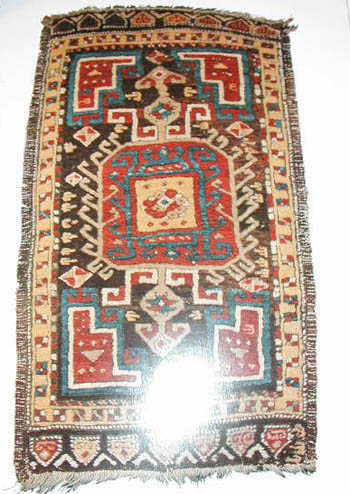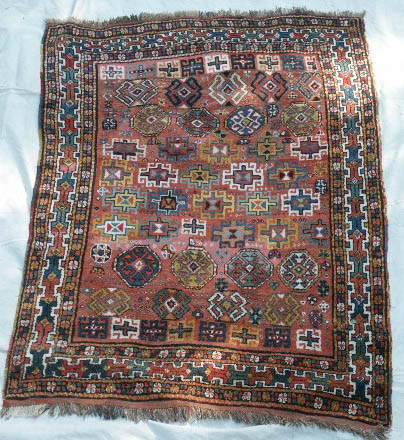







East Anatolian Fragment
This must qualify as a fragment, however you define one. It's about 3 x 5.5
feet, has some goat? hair in the foundation. It has many colors with several
blues and browns (note subtle contrast of one brown versus the apricot
background of the main border in the corner image below). I'm no expert, but I'd
guess the purple is from cochineal. The light blue (not the electric blue of the
center panel, but the light blue in border forms) doesn't seem to be from
sulphonic, same for the blue greens. Similar to a few plates in Eagleton, but
with more and brighter colors. Can anyone direct me to other published rugs or
say more about it? thanks ... 







Sivas?
Bob:
Although Eagleton alternates between Gaziantep and Malatya as the
place of origin for these rugs, people in Turkey today would probably place this
further north - near Sivas. It is Kurdish.
Eagleton also seems to see
Armenian and Caucasian influence in these pieces; perhaps due to similarity with
some flatweave and related rug designs that are common there. I suggest you
consider so-called large pattern Holbein rugs as a possible design source.
The electric blue in your rug is pretty distinctive, and it seems to
have a different color value, as seen on my monitor, from some of the other
colors; likewise the cherry red. The purple is difficult to judge, but does not
appear to be madder. I like the negative images in your border.
I will
defer to others on whether this constitutes a fragment, but I would prefer to
think of it as a relic as opposed to a wreck.
Best wishes, Michael
Water Tank
Bob,
I would certainly call your rug a fragment, but quite a
delightful one.
The design in your rug looks like the typical Kurdish
"water-tank" design.
An example is shown on the Jozan website:
Yours
is quite obviously Eastern Anatolian. The colors, especially the apricot, along
with some of the other minor motifs, all point in that direction. The apricot
color is common in so-called "Yoruk" rugs from Eastern Anatolia, although some
authors have argued for a more specific description, such as Kurdish, for this
type of rug.
I do not know of any study showing where the design originated,
although it is more formally found to the east, in Khorasan.
In James
Burns book, a rug with this design is shown (plate 99). He notes that other
sources say the design may derive from a garden, or the "hauzi"-water-tank.
Burns believes it may be a representation of the 'abyss" from the Yazdi
religion.
I, of course, prefer the interpretation that these are symbolic
of the heat exchange systems of archaic nuclear power plants. 
Patrick Weiler
Hi Bob,
Nice specimen.
You can find another example here:
from An Exhibition of Traditional Kurdish Rugs Organized by Michael
Wendorf and Sponsored by The Near Eastern Art Research
Center
Regards,
Filiberto
thanks
it's a tough one to photograph: if the blues look right then the red's off a bit. the subtle color differences, such as the cinnamon partial main border form in the corner image, get lost. in person this color is clearly different from the apricot background of the main border and the cinnamon seems longer than the apricot.
Yoruk/Kurd
Dear Readers:
Yoruk referring to nomad or wanderer in Turkey is too
generic. In my experience, these rugs as represented by Bob's fragment are known
as Kurdish weavings even by people who hesitate to apply ethnic tags. There are
simply too many of them that have been directly sourced from Kurdish groups to
conclude otherwise. That said, there is quite a difference between the example
referenced by Filiberto and Bob's example. The piece exhibited in 1999 has a
great deal of a soft old green in it as well as extensive use of a burnt orange
and a clear yellow. In addition, there were clearly three separate compartments
as a design construct where Bob's rug can be read as three vertical medallions -
only the change in ground color expresses the compartmentalization that is
typical of the group.
I am not certain what Patrick means when he writes
that the design is more formally found in the east, in Khorasan. There is a
Kurdish enclave there that makes many rugs with similar motifs in the field and
the Jozan example is one of them. They never seem very formal to me and I would
tend to think of them as derivative of an older Anatolian tradition. If these
are water tanks and related to garden imagery then you would want to consider
Persian garden design sources. I still think one would be well served to
consider so-called Holbein prototypes.
An interesting group.
Best
wishes, Michael
Michael, thanks, yes I see the LPHolebin influence. Compared to the rug in your exhibit, my beat-up one is smaller, has cochineal, and has brighter colors (electric blue, strong red). Maybe last quarter? Fun little rug.
Formality
Michael,
What I meant to say was a more formal or standardized version
of the water-tank design was woven in the Khorasan area. Not that they wove them
while wearing formal clothing. I need some remedial grammar lessons.
Bob's
rug is a more rustic rendition of the design.
If, in fact, the design
originated in the Eastern Anatolian region, then Bob's rug is a direct
descendent of the original. The Khorasan version was brought there from the
Anatolian region, a derivative of the original design, just as you say. The
Anatolian version morphed and modified over the years.
Formally
yours,
Patrick Weiler
Hi Bob,
Looking for something else, I found this in Hali 25 page
20:
Said
to be Yoruk, East Anatolia, 109x221 cm.
Notice the
border.
Regards,
Filiberto
thanks filiberto, here is a yastik from the recent textile museum anatoilan
show that captures the LPHolbein feel of my rug with descending pendants, and a
more naively drawn cool version of the rug from a friend's private
collection:

Hi Bob and all
First, a Merry Christmas to all who peep in these days.
Wonderful colours. No doubt the piece is tribal or village and therefore
it is difficult to imagine how the weaver should have come by indigosulphonic
acid. That dye was used by workshops not before the middle of 19th century I
should think. No, it just is a very nice light blue.
As to the origin,
several areas seem possible. At least theoretically. One is Quchan in Khorassan.
In Jenny Housego’s book on tribal rugs you can find an illustration. I haven’t
got it here, therefore I cant tell the plate number.
Another might be the
Varamin area where some of the Kurdish groups that left the southern Caucasus
settled whilst others went on to Khorassan.
This implies that the
southern slopes of the Caucasus or the Moghan steppes might be another origin,
where some Kurdish groups formed part of the Shasevan confederation. Before they
joined centuries ago they had lived around mount Ararat in eastern Turkey. It
might be possible that the design has survived there amongst remnants. I am not
suggesting that the design itself goes back to the middle ages, but Kurdish
weavers in eastern Turkey may have picked it up from their relatives in
Azerbaidjan. There always was ample travelling in those parts. The relation to
Persian formal garden carpets has been suggested in the literature. This does
not need to mean that the design itself is not older than those garden carpets.
Due to a more sophisticated organisation of society and with it going a division
of labour, workshops contracted by the courts in Ardebil or Tabris may have
taken up the design and developed it further. It’s one of the short-comes in
popular rug literature that it is usually assumed that designs were handed down
from court to peasants. In that region courts still were quite solidly rooted in
their tribal ancestry. Designs did not travel one one-way streets.
I
appreciate the link to Holbein patterns for the central medaillons as well. It
seems to be there anyway with regard to the hooked medaillons in the main
borders.
Back to your rug. I have not seen a rug like yours with a
“certified” attribution to the west. The colours seem so fresh, looking at it,
the Caucasus does not seem to be far and some good 19th century Moghan rugs and
kasaks come to my mind. Also some centres of those hooked medaillons in the main
border of your rug show motives that are known from the Caucasus: allegedly they
are called “animal hides” amongst old Armenian rug dealers (Doris Eder, 1990).
It is my impression that they also form the vertical axis of the well known Lori
Pampak Medaillon. Actually, the contours of the central medaillons of your rug
can be linked to those red polygones in Karachoph type II rugs.
All the
rugs of the type of yours that I have looked at and have held in hands came from
Khorassan. If that is where yours comes from as well, then (with a little bid of
extrapolation due to fine colours and execution of details) it should be middle
19th century, not later, perhaps earlier. I have one with a different design and
colours similar to yours but not quite the same quality, reliably dated 3rd
quarter 19th century. Here are a couple of pictures:

Regards
Horst
Hallo Bob
I realised I have given you the wrong reference. The proper
one is: Brüggemann W, Böhmer H (1982) Teppiche der Bauern und Nomaden
Anatoliens, München. Plate numbers are correct. The English title should read
something like “Rugs of the Peasants and Nomads of Anatolia”.
Sorry for
this.
Horst